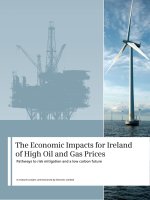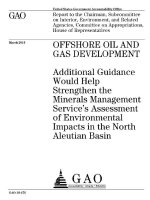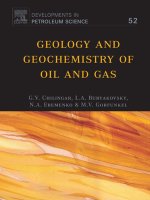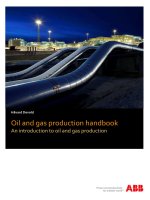oil and gas basics jp morgan (2008)
Bạn đang xem bản rút gọn của tài liệu. Xem và tải ngay bản đầy đủ của tài liệu tại đây (846.27 KB, 73 trang )
M A R C H 2 0 0 8
O I L & G A S B A S I C S
S T R I C T L Y P R I V A T E A N D C O N F I D E N T I A L
Katherine Spector
(1-212) 834-2031
Scott Speaker
(1-212) 834-3878
Kristi Jones
(1-212) 834-2835
Sung Yoo
(1-212) 834-7045
Sachin Kirtane
(1-212) 834-8046
Oil & Gas Basics_20080324
This presentation was prepared exclusively for the benefit and internal use of the client in order to indicate, on a preliminary basis, the feasibility of a
possible transaction or transactions and does not carry any right of publication or disclosure to any other party. This presentation is incomplete without
reference to, and should be viewed solely in conjunction with, the oral briefing provided by JPMorgan. Neither this presentation nor any of its contents
may be used for any other purpose without the prior written consent of JPMorgan.
The information in this presentation is based upon management forecasts and reflects prevailing conditions and our views as of this date, all of which are
subject to change. In preparing this presentation, we have relied upon and assumed, without independent verification, the accuracy and completeness of
all information available from public sources or which was provided to us by or on behalf of the client or which was otherwise reviewed by us. In addition,
our analyses are not and do not purport to be appraisals of the assets, stock, or business of the client. The information in this presentation does not take
into account the effects of a possible transaction or transactions involving an actual or potential change of control, which may have significant valuation
and other effects.
JPMorgan is a marketing name for investment banking businesses of J.P. Morgan Chase & Co. and its subsidiaries worldwide. Securities, syndicated loan
arranging, financial advisory and other investment banking activities are performed by J.P. Morgan Securities Inc. and its securities affiliates, and lending,
derivatives and other commercial banking activities are performed by JPMorgan Chase Bank and its banking affiliates. JPMorgan deal team members may
be employees of any of the foregoing entities.
O I L & G A S B A S I C S
Agenda
Page
Oil & Gas Basics_20080324
References, Websites and Data Releases to Watch
LNG
Natural Gas Specifics
Geopolitics, policy and economics
Interpreting the curve- why market participation matters
How oil is priced – terms and conventions
The energy investment cycle
Where does oil comes from - and where does it go?
1
1
7
11
22
46
54
60
65
O I L & G A S B A S I C S
Oil & Gas Basics_20080324
From the well to the tank. . .
Source: JPMorgan Energy Strategy
2
W H E R E D O E S O I L C O M E S F R O M - A N D W H E R E D O E S I T G O ?
Oil & Gas Basics_20080324
Where are most of the world’s oil reserves?
Source: JPMorgan Energy Strategy, BP Statistical Handbook (June 2007)
Proved Oil Reserves (end 2006)
Proved Oil Reserves (end 2006)
40.5
59.9
117.2
103.5
144.4
742.7
Asia Pacific North America Africa South & Central
America
Europe & Eurasia Middle East
In thousand million barrels
3
W H E R E D O E S O I L C O M E S F R O M - A N D W H E R E D O E S I T G O ?
Oil & Gas Basics_20080324
Producer
Volume
Russia 9396
Saudi Arabia
8423
US
5103
Iran
3983
China
3729
Mexico
3083
UAE
2494
Venezuela
2419
Kuwait
2168
Nigeria
2162
Iraq
2083
Norway
2062
Canada
1930
Brazil
1748
Libya
1743
UK-offshore
1433
Angola
1371
Algeria
1363
Kazakhstan
1289
Azerbaijan
860
Indonesia
843
Qatar
812
Argentina
763
Oman
713
India
699
Malaysia
695
Egypt
633
2.8%
4.7%
4.4%
3.6%
2.9%
Share of Global Production
11.0%
9.9%
6.0%
2.5%
2.5%
2.4%
2.4%
1.5%
1.0%
2.3%
2.0%
2.0%
1.7%
0.8%
0.8%
0.7%
1.0%
1.0%
0.9%
0.8%
1.6%
1.6%
Who are the world’s top producers of crude oil?
The world’s biggest producers are not
necessarily the same as the world’s
biggest exporters. For example, the US
and China produce a lot of oil, but
export very little given high domestic
demand
OPEC members Saudi Arabia and Iran
are the world’s biggest exporters of
crude oil
2007 Averages (kbd)
2007 Averages (kbd)
Note: Bold = OPEC members
Source: JPMorgan Energy Strategy, IEA
4
W H E R E D O E S O I L C O M E S F R O M - A N D W H E R E D O E S I T G O ?
Oil & Gas Basics_20080324
How is crude oil related to other oils, like gasoline and heating oil?
Crude oil is what gets pumped out of the ground. Very little crude oil is consumed directly — it is a
raw material that has to be refined into other products, such as gasoline and heating oil
Oil refining is the process of turning crude into the fuels that we use every day, such as gasoline,
heating oil, and jet fuel. Though refining processes differ according to the desired product, all begin
by heating crude at increasing temperatures to separate it into component parts
Source: JPMorgan Energy Strategy
Re
Refining process
Alkylation
Catalytic Reforming
Hydrocracker
Catalytic Cracker
Coker/Thermal Cracker
Hydrogen
Chemicals
Gasoline
Gasoline
Kerosene
Gasoline
Gasoil/Diesel
Naphtha
Gasoline
Heavy Gas Oil
Coke
Gasoline Blending Components
5
W H E R E D O E S O I L C O M E S F R O M - A N D W H E R E D O E S I T G O ?
Oil & Gas Basics_20080324
Top Oil Consumers (2006)
Top Oil Consumers (2006)
Where are the world’s top consumers of oil?
FSU
5%
Japan
6%
China
9%
United States
25%
Other
49%
India
3%
Germany
3%
Source: JPMorgan Energy Strategy, BP Statistical Handbook (June 2007)
6
W H E R E D O E S O I L C O M E S F R O M - A N D W H E R E D O E S I T G O ?
Agenda
Page
Oil & Gas Basics_20080324
References, Websites and Data Releases to Watch
LNG
Natural Gas Specifics
Geopolitics, policy and economics
Interpreting the curve- why market participation matters
How oil is priced – terms and conventions
The energy investment cycle
Where does oil comes from - and where does it go?
7
1
7
11
22
46
54
60
65
O I L & G A S B A S I C S
Oil & Gas Basics_20080324
Energy markets cycle through periods of over- and under-investment
Low prices discourage investment all along the supply chain. As demand grows, spare capacity falls
and prices rise. High prices spur new investment. The lead-times for energy industry investment
means that periods of over-and under-capacity don’t go away over night…. But the market always
does it’s job eventually!
1,000
2,000
3,000
4,000
5,000
6,000
7,000
'75 '77 '79 '81 '83 '85 '87 '89 '91 '93 '95 '97 '99 '01 '03 '05 '07
# Rigs
$-
$20
$40
$60
$80
$100
$120
$140
$/bbl (real)
Global Rig Count (Left)
Real Price of Crude (Right)
Source: JPMorgan Energy Strategy
Baker Hughes World Oil & Gas Rig Count and Crude Price
Baker Hughes World Oil & Gas Rig Count and Crude Price
8
T H E E N E R G Y I N V E S T M E N T C Y C L E
Oil & Gas Basics_20080324
The cycle of investment
OECD Oil Demand vs. Refinery Capacity
OECD Oil Demand vs. Refinery Capacity
In million b/d
20
25
30
35
40
45
50
55
'84 '86 '88 '90 '92 '94 '96 '98 '00 '02 '04 '06
Refined Products Import Gap
Refinery Capacity
Oil Demand
Source: JPM Energy Strategy, IEA, EIA
Downstream investment, or lack
thereof, is also cyclical and tends to
over-shoot in both directions
There’s no reason to think that this
investment cycle won’t — eventually —
be the same
OECD demand exceeds OECD refinery
capacity. That means that, increasingly,
‘spare’ refinery capacity is in the non-
OECD. That means that — just like
crude production — most of the world’s
refined products production is
geographically far away from most of
the world’s consumption
0
9
T H E E N E R G Y I N V E S T M E N T C Y C L E
Oil & Gas Basics_20080324
Energy infrastructure/distribution capacity is still a constraint
Global Oil Demand Supplied By International Trade
Global Oil Demand Supplied By International Trade
More refined products, in particular, have to travel greater distances to their end user. Ports,
pipes, tankers, etc. are all an issue — will they see the investment boom that refining is seeing?
Oil Trade:Oil Demand
30%
35%
40%
45%
50%
55%
60%
1987 1988 1989 1990 1991 1992 1993 1994 1995 1996 1997 1998 1999 2000 2001 2002 2003 2004 2005 2006
1987-91: 46%
1992-96: 53%
1997-01: 56%
2002-06: 60%
Source: JPMorgan Energy Strategy, BP Statistical Handbook
Crude Refined Products
1987-1995 3.6% 1.8%
1996-2005 2.5% 3.8%
2001-2005 1.7% 5.4%
Growth In Waterborne
Crude & Products Transport
Source: Clarkson's Shipping Review
0%
10
T H E E N E R G Y I N V E S T M E N T C Y C L E
Agenda
Page
Oil & Gas Basics_20080324
References, Websites and Data Releases to Watch
LNG
Natural Gas Specifics
Geopolitics, policy and economics
Interpreting the curve- why market participation matters
How oil is priced – terms and conventions
The energy investment cycle
Where does oil comes from - and where does it go?
11
1
7
11
22
46
54
60
65
O I L & G A S B A S I C S
Oil & Gas Basics_20080324
Oil is a global market
It’s impossible for oil prices to go up in one part of the world, without
prices in other parts of the world being impacted
If there is a disruption in any producing country that affects prices, that
disruption will affect prices everywhere, even in countries that do not get
crude supplies from the country with the disruption
Broadly speaking, oil is fungible: a commodity that is freely
interchangeable with another in satisfying an obligation
12
H O W O I L I S P R I C E D – T E R M S A N D C O N V E N T I O N S
Oil & Gas Basics_20080324
Is all crude oil the same?
There are many different grades of crude oil. All grades have different qualities, and sell for
different prices based on their qualities
When we talk about ‘light,
sweet’ crude, we mean grades
with a high API gravity number,
and a low sulfur content. A
‘heavy, sour’ crude has a low
API gravity and a high sulfur
content
In general, light/sweet crude
tends to sell at a higher price
than heavy/sour crude
In general, refiners can produce
a higher yield of high quality
refined products, such as
gasoline, by running light/sweet
crudes. Heavy/sour grades yield
less gasoline, and more of the
‘dirty’ products such as fuel oil
Source: JPMorgan Energy Strategy
13
H O W O I L I S P R I C E D – T E R M S A N D C O N V E N T I O N S
Oil & Gas Basics_20080324
Major global crude benchmarks and oil market centers
Dubai
London (IPE)
Dated Brent
Urals
WTI
New York
(NYMEX)
Tapis
Singapore
Oman
Source: JPMorgan Energy Strategy
14
H O W O I L I S P R I C E D – T E R M S A N D C O N V E N T I O N S
Oil & Gas Basics_20080324
Source: JPMorgan Energy Strategy
How oil (gas, etc.) trades
Formal Exchanges (futures)
Int’l Petroleum Exchange
(London)
Brent Crude
1 lot = 1,000 bbl
Gas Oil
1 lot = 100 tonnes = 750 bbl
NY Mercantile Exchange
West Texas Intermediate
(‘Light, Sweet’) Crude
1 lot = 1,000 bbl
Heating Oil
1 lot = 42,000 gallons = 1,000 bbl
Unleaded Gasoline
1 lot = 42,000 gallons = 1,000 bbl
Henry Hub Natural Gas
1 lot = 10,000 MMBtu
Over-the-Counter (swaps)
Swaps/Options
Variety Of Regional
Benchmark Crudes and
Refined Products. . .
15
H O W O I L I S P R I C E D – T E R M S A N D C O N V E N T I O N S
Oil & Gas Basics_20080324
How to look at the futures screens
Nymex CL (crude) Nymex HO (heat)
Time spreads
—
e.g. Q1 vs. Q3; winter vs. summer, Cal 05
vs. Cal 06
Regional spreads
—
e.g. NYMEX West Texas Intermediate vs.
IPE Brent, NY Harbor gasoline vs. US Gulf
gasoline
Crude vs. refined product spreads
—
‘Cracks’ (e.g. crude-gasoline;
crude-heating oil)
—
Refinery margins
Crude grade differentials (physical trade only)
—
e.g. West Texas Intermediate vs.
West Texas Sour; Bonny Light vs. Brent
Product vs. product spreads
—
e.g. gasoline-heating oil
Interfuel spreads
—
e.g. natural gas-heating oil
Relationships To Watch
Relationships To Watch
16
H O W O I L I S P R I C E D – T E R M S A N D C O N V E N T I O N S
Oil & Gas Basics_20080324
Price relationships to watch. . .and what JPMorgan trades
Time spreads
—
e.g. Q1 vs. Q3; winter vs. summer, Cal 05
vs. Cal 06
Regional spreads
—
e.g. NYMEX West Texas Intermediate vs.
IPE Brent, NY Harbor gasoline vs. US Gulf
gasoline
Crude vs. refined product spreads
—
‘Cracks’ (e.g. crude-gasoline;
crude-heating oil)
—
Refinery margins
Crude grade differentials (physical trade only)
—
e.g. West Texas Intermediate vs.
West Texas Sour; Bonny Light vs. Brent
Product vs. product spreads
—
e.g. gasoline-heating oil
Interfuel spreads
—
e.g. natural gas-heating oil
Oil
Crude
—
WTI
—
Brent
—
Tapis
—
Dubai
Refined products
US market:
—
NYMEX heating oil
—
US Gulf Coast heating oil
—
US Gulf Coast jet fuel
—
NYMEX gasoline
European market:
—
IPE gasoil
—
Gasoil 0.2% CIF NWE
—
Jet fuel cargoes CIF NWE
—
EN590 cargoes CIF NWE
—
1% and 3.5% fuel oil cargoes FOB NWE
Asian market:
—
Singapore jet fuel
Natural Gas:
NYMEX natural gas
European natural gas priced as oil-referenced
formula
17
H O W O I L I S P R I C E D – T E R M S A N D C O N V E N T I O N S
Oil & Gas Basics_20080324
Some futures curves are seasonal
Some futures curves assume a more or
less standard seasonality
For example, the heating oil and
natural gas curves always reflect the
expectation that heating oil and natural
gas will be more expensive in the
winter. The gasoline curve reflects the
expectation that gasoline will be more
expensive in the summer
Traders look for opportunities to take
advantage of abnormalities in the
typical seasonality of the curves
Natural Gas
Natural Gas
Gasoline vs. Heating Oil
Gasoline vs. Heating Oil
6
7
8
9
10
11
Mar08 Aug08 Jan09 Jun09 Nov0 Apr10 Sep10 Feb11 Jul11 Dec11
$/MMBtu
Source: JPMorgan Energy Strategy
Delivery Month
$/gallon
$2.20
$2.40
$2.60
$2.80
$3.00
$3.20
Apr08 Sep08 Feb09 Jul09 Dec09 May1 Oct10 Mar11 Aug11
Delivery Month
NYMEX Heating Oil
NYMEX Gasoline
Source: JPMorgan Energy Strategy
18
H O W O I L I S P R I C E D – T E R M S A N D C O N V E N T I O N S
Oil & Gas Basics_20080324
Conventions of the oil market
Commodity Lot Size Quote Unit
Crude (global) 1,000 barrels US$/barrel
Gasoline (US) 42,000 gallons cents/gallon
Heating oil (US) 42,000 gallons cents/gallon
Gas oil (Europe) 100 metric tons US$/metric ton
Jet fuel (Europe) 100 metric tons US$/metric ton
Natural gas (US) 10,000 MMBtu US$/MMBtu
Benchmarks
Benchmarks
Barges: 1,000 - 5,000 MT (2 - 8 days loading)
Cargoes: 10,000 - 25,000 MT (15 days loading)
Parcel
Parcel
Delivery specifications are factored into the cost of products. For example
— Free on Board (“FOB”)
— Cost Insurance Freight (“CIF”)
In the US, products may be priced as “pipe”, “barge”, or “waterborne” based on delivery method
Delivery Methods
Delivery Methods
Europe: Amsterdam-Rotterdam-Antwerp; Arab Gulf; Mediterranean; North West Europe; Rotterdam.
United States: New York Harbour; Los Angeles; San Francisco; US Gulf Coast; Midcontinent; West Coast.
Singapore
Main Locations
Main Locations
Source: JPMorgan Energy Strategy
19
H O W O I L I S P R I C E D – T E R M S A N D C O N V E N T I O N S
Oil & Gas Basics_20080324
For example. . .
What is the price of spot fuel oil (a heavy, refined product) relative to crude?
What region? Europe.
Rotterdam or Med? Med.
What sulphur content? 1%.
CIF or FOB? CIF.
Barge or cargo? Cargo. $239/tonne
Compare to what crude? Urals.
€36.60 x $1.34 - $239 x 1 tonne = $13.16/bbl
1 bbl Urals €1 1 tonne FO 6.66 bbl
Extensions of this idea?
Look at the forward spreads; look at the spread to the US or Asian fuel cracks
Warning!
When using futures to compare different products, check for varying expiration dates.
20
H O W O I L I S P R I C E D – T E R M S A N D C O N V E N T I O N S
Oil & Gas Basics_20080324
Market drivers to watch – lots of moving parts!
Macro economy
— Sectoral trends – are growth sector
energy intensive?
— Power generation trends what kind
of fuel does new generation use?
— Transportation trends – number and
type of cars sold?
— Tax and subsidy regimes – distort
price signals to consumers and
affect their consumption behavior…
Weather, seasonality – winter heating
demand, summer cooling demand,
holidays, vacation and travel trends
Non-oil fuel markets, substitution
(e.g. gas, coal, hydro, nuclear)
Misc events – e.g. SARS, Sep. 11
Upstream investment – capacity
additions? Cost? Location? Type of
crude?
Natural decline rates – Field age, field
maintenance, geological makeup
Geopolitics (e.g. Iran, Nigeria)
Field maintenance, unplanned outages
Weather (e.g. hurricanes)
OPEC decisions and politics – internal
politics, spare capacity, relationships
with consumer countries
Level relative to long term trend and
normal seasonality
Level relative to demand
Regional distribution
Levels at transit points
Crude versus refined product levels
Oil Demand
Oil Demand
Oil Supply
Oil Supply
Oil Inventories
Oil Inventories
Deals associated with
mergers/acquisitions
Speculative flows
Tanker supply/demand/rates
Seaborne disruptions – weather, traffic,
accidents
Port capacity, availability
Pipeline capacity/nominations
Refinery capacity/investment
Planned outages, unplanned outages
Refining economics, run rates
Refined product yields
Other
Other
Distribution
Distribution
Oil Refining
Oil Refining
Source: JPMorgan Energy Strategy
21
H O W O I L I S P R I C E D – T E R M S A N D C O N V E N T I O N S
Agenda
Page
Oil & Gas Basics_20080324
References, Websites and Data Releases to Watch
LNG
Natural Gas Specifics
Geopolitics, policy and economics
Interpreting the curve- why market participation matters
How oil is priced – terms and conventions
The energy investment cycle
Where does oil comes from - and where does it go?
22
1
7
11
22
46
54
60
65
O I L & G A S B A S I C S
Oil & Gas Basics_20080324
$10
$20
$30
$40
$50
$60
$70
$80
$90
$100
’95 ’96 ’97 ’98 ’99 ’00 ’01 ’02 ’03 ’04 ’05 ’06 ’07 ’08
$/bbl
Source: JPMorgan Energy Strategy
Futures are not a prediction of price
Nymex WTI — Up in the Front, Up in the Back
Nymex WTI — Up in the Front, Up in the Back
M01 price
As predicted by M12 fwd — one year earlier
As predicted by M24 fwd — two years earlier
Futures tell us where a buyer of tomorrow’s crude can find a seller of tomorrow’s crude in
the market today
Futures are not necessarily a commentary on what market participants believe about the
future
23
I N T E R P R E T I N G T H E C U R V E - W H Y M A R K E T P A R T I C I P A T I O N M A T T E R S









